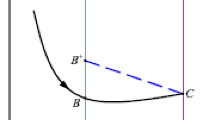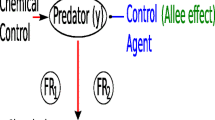Abstract
In this paper, we develop a two-dimensional Lotka–Volterra prey–predator model based on crop and pest. Pontryagin’s maximum principle is deployed to address the control issue of the prey–predator system, with the interaction of the coefficients of the Lotka–Volterra equations as the main input. The optimal control techniques are utilized to enhance agricultural yields while decreasing the predator population, which harms the crops. Control variables are utilized in two ways: one is applied to the predator, which kills the predator, and the other is applied to the crops, which support plant development and soil fertility. The rate of sprayed pesticides is the first control variable and the second control variable is the regularity of usage of organic biomass fertilizers. Furthermore, we establish the existence of an optimal control, the required work out the criteria for optimality, and then carry out numerical computations.
Access this chapter
Tax calculation will be finalised at checkout
Purchases are for personal use only
Similar content being viewed by others
References
Al Basir, F., Banerjee, A., Ray, S.: Role of farming awareness in crop pest management—a mathematical model. J. Theor. Biol. 461, 59–67 (2019)
Abraha, T., Basir, F.A., Obsu, L.L., Torres, D.F.M.: Pest control using farming awareness: impact of time delays and optimal use of biopesticides. Chaos, Solitons Fractals 146, 110869 (2021)
Anguelov, R., Dufourd, C., Dumont, Y.: Mathematical model for pest-insect control using mating disruption and trapping. Appl. Math. Model. 52, 437–457 (2017)
Arora, C., Kumar, V.: Dynamics of a high-dimensional stage-structured prey-predator model. Int. J. Appl. Comput. Math. 3(1), 427–445 (2017)
Birkoff, G., Rota, G.C.: Ordinary Differential Equations. Ginn, Boston (1982)
Chakraborty, K., Chakraborty, M., Kar, T.: Optimal control of Harvest and bifurcation of a prey–predator model with stage structure. Appl. Math. Comput. 217, 8778–8792 (2011)
Danca, M., Codreanu, S., Bako, B.: Detailed analysis of a nonlinear prey–predator model. J. Biol. Phys. 23, 11–20 (1997)
Aktar, M.W., Sengupta, D., Chowdhury, A.: Impact of pesticides use in agriculture: their benefits and hazards. Interdisc. toxicol. 2(1), 1–12 (2009)
Fleming, W.H., Rishel, R.W.: Deterministic and Stochastic Optimal Control. Springer-Verlag, New York (1975)
Kar, T.K., Batabyal, A.: Stability analysis and optimal control of an SIR epidemic model with vaccination. Biosystems 104, 127–135 (2011)
Kant, S., Kumar, V.: Analysis of an eco–epidemiological model with migrating and refuging prey. Math. Anal. Its Appl., pp. 17–36 (2015)
Lenhart, S., Workman, J.T.: Optimal Control Applied to Biological Models. Mathematical and Computational Biology Series. Chapman & Hall/CRC, London (2007)
Mehra, M., Mallik, R.K.: Solutions of differential difference equations arising from mathematical models of granulocytopoiesis. Differ. Eqn. Dyn. Syst. 22(1), 33–49 (2014)
Mehra, M., Kumar, V.: Fast wavelet-Taylor Galerkin method for linear and non-linear wave problems. Appl. Math. Comput. 189(2), 1292–1299 (2007)
McCalmont, J.P., Hastings, A., McNamara, N.P., Richter, G.M., Robson, P., Donnison, I.S., Clifton, B.J.: Environmental costs and benefits of growing Miscanthus for bioenergy in the UK. GCB Bioenergy 9(3), 489–507 (2017)
Nassir, S.A.L.: The dynamics and optimal control of a prey-predator system. Glob. J. Pure Appl. Math. 13(9), 5287–5298 (2017)
Pontryagin, L.S., Boltyanskii, V.G., Gamkrelidze, R.V., Mishchenko, E.F.: The Mathematical Theory of Optimal Processes. Gordon and Breach Science Publishers (1986)
Rafikov, M., Balthazar, J.M., von Bremen, H.F.: Mathematical modeling and control of population systems: applications in biological pest control. Appl. Math. Comput. 200, 557–573 (2008)
Ritter, L.: For the ad hoc panel on pesticides and cancer. Report of a panel on the relationship between public exposure to pesticides and cancer. Cancer 80, 2019–2033 (1997)
State of Indian Agriculture, p. 247. Published by Department of Agriculture & Cooperation, Govt. of India, New Delhi (2012–13)
Sasmal, S.K., Mandal, D.S., Chattopadhyay, J.: A predator-pest model with Allee effect and pest culling and additional food provision to the predator-application to pest control. J. Biol. Syst. 25(02), 295–326 (2017)
Thind, Singh, T.: Perspectives on crop protection in India. Outlooks Pest Manage. 26(3), 121–127(7) (2015)
Kumar, V., Mehra, M.: Wavelet optimized finite difference method using interpolating wavelets for solving singularly perturbed problems. J. Wavelet Theory Appl. 1(1), 83–96 (2007)
Kumar, V., Srinivasan, B.: A novel adaptive mesh strategy for singularly perturbed parabolic convection diffusion problems. Differ. Eqn. Dyn. Syst. 27(1), 203–220 (2019)
Van Driesche, R.G., Bellows, J.T.S.: Biological Control. Chapman and Hall, New York (1996)
Van den Bosh, R., Messenger, P.S., Gutierrez, A.P.: An Introduction to Biological Control. Plenum Press, New York (1982)
Yadav, S., Kumar, V.: Study of a prey-predator model with preventing crop pest using natural enemies and control. AIP Conf. Proc. 2336(1), 020002 (2021)
Yadav, S., Kumar, V.: A prey–predator model and control of a nematodes pest using control in banana: Mathematical modeling and qualitative analysis. Int. J. Biomathematics 2150089 (2021)
Acknowledgements
The authors are grateful to the reviewers for helpful and relevant suggestions.
Author information
Authors and Affiliations
Corresponding author
Editor information
Editors and Affiliations
Rights and permissions
Copyright information
© 2023 The Author(s), under exclusive license to Springer Nature Singapore Pte Ltd.
About this paper
Cite this paper
Yadav, S., Kumar, V. (2023). Mathematical Analysis of a Prey–Predator Model in Presence of Two Controls. In: Sahni, M., Merigó, J.M., Hussain, W., León-Castro, E., Verma, R.K., Sahni, R. (eds) Mathematical Modeling, Computational Intelligence Techniques and Renewable Energy. Advances in Intelligent Systems and Computing, vol 1440. Springer, Singapore. https://doi.org/10.1007/978-981-19-9906-2_15
Download citation
DOI: https://doi.org/10.1007/978-981-19-9906-2_15
Published:
Publisher Name: Springer, Singapore
Print ISBN: 978-981-19-9905-5
Online ISBN: 978-981-19-9906-2
eBook Packages: Intelligent Technologies and RoboticsIntelligent Technologies and Robotics (R0)




